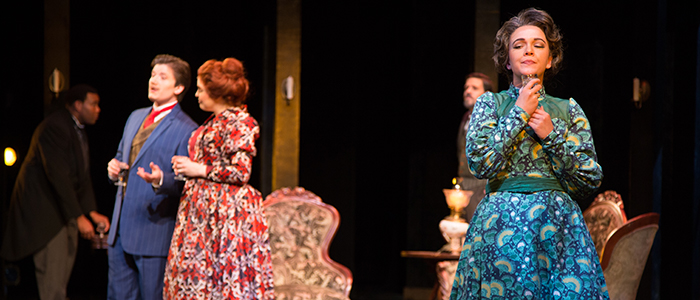Regina: All Hail the Queen!
This blog post is by Chelsey McLaughlin, a senior theatre major.

Regina photo by Geoff Sheil
From balcony seat 20, row AA, I have an aerial view into the orchestra and of the red velvet curtain which currently covers the stage. A soft, chaotic jumble of music notes fills the dimly lit theatre as the strings, brass and woodwinds warm their instruments in preparation for the opera. The audience is slowly filing in and a gray-haired woman to my right excitedly whispers, “we have the best seats in the house,” to which I eagerly agree.
As the lights go down and a triumphant tune begins, the curtain rises to reveal a beautiful, black grand staircase whose cascading U-shape begins upstage, stage right and arcs in a curve that ends downstage, stage left. As the eye descends the staircase toward the black and gold marble floors, one cannot help but notice the clusters of baroquely embroidered, gold picture frames suspended from the ceiling devoid of pictures. Beneath the staircase, lives an ornately decorated, spacious living room with a back hallway visible to the audience bordered by thin black columns. Adjacent a nearly 30-foot window clad in heavy ruby curtains with gold tassels, hangs several antique golden chandeliers which shine against the textured back walls and highlight this stunning asymmetrical set.
Off-setting the grandeur of this set is the chaotic storyline of this work whose constant evolution of events makes it aptly deserving of its own daytime soap opera. Marc Blitzstein’s Regina, the 3-act opera based on Lillian Hellman’s play The Little Foxes, tells the story of a trio of Southern siblings who aspire to amass self-made wealth by any means necessary in the Alabama South. The flame-haired protagonist, Regina, uses her beauty and esteem to her advantage to outwit her brothers, subvert her husband and manipulate her daughter—all while throwing the most lavish southern party in her home.
The infusion of ragtime and gospel music anchors this piece it in its early 20th century time period, all the while underscoring its southern roots. Regina’s traditional southern party was the perfect time for the upbeat ragtime music to display the quick-paced choreography and the splendid assortment of evening wear. Smooth satins spanning the palate of bright pastels, the costumes provided a striking contrast to the richness of the set; although, at times the fabric colors appeared almost too effervescent against the deep scheme of ruby, black and gold. However, much like innocent daughter Alexandra, these shimmering colors served as a herald of hope in the midst of Horace's failing health and the scheming intentions of the Hubbard men. Regina’s tireless pursuit for power forces great change within the family — forcing some members to confront their hidden agendas, while allowing others to find their own voice.
